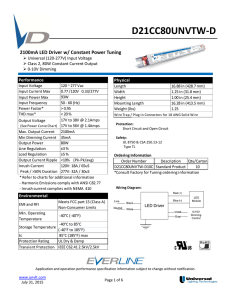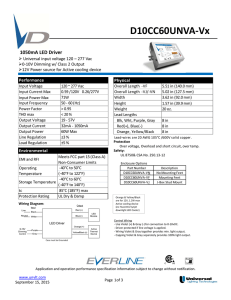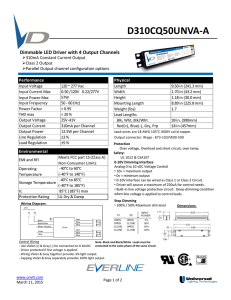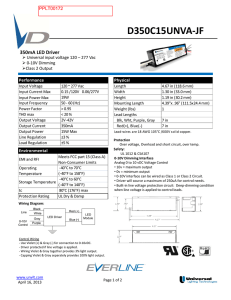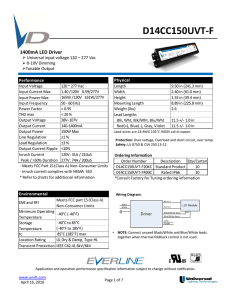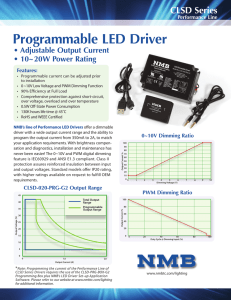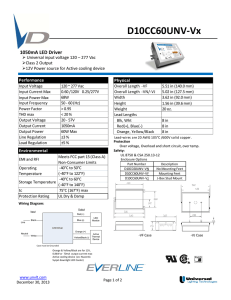D10CC55347TW-C - Universal Lighting Technologies
advertisement
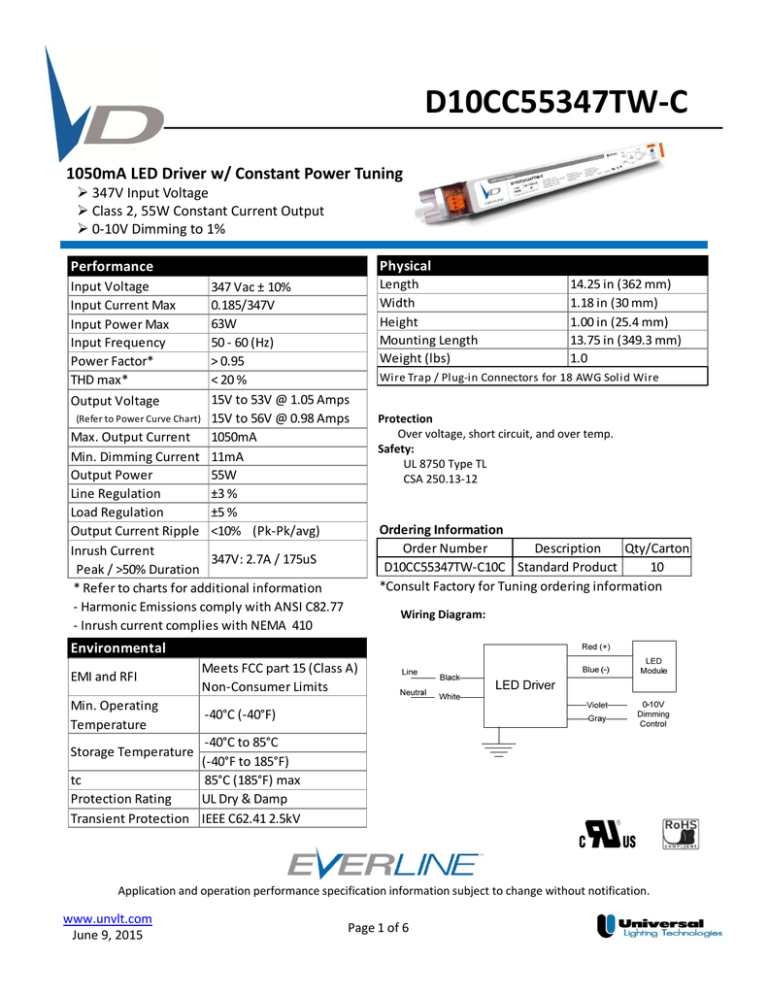
D10CC55347TW‐C 1050mA LED Driver w/ Constant Power Tuning ¾ 347V Input Voltage ¾ Class 2, 55W Constant Current Output ¾ 0‐10V Dimming to 1% Performance Physical Input Voltage Input Current Max Input Power Max Input Frequency Power Factor* THD max* Output Voltage Length Width Height Mounting Length Weight (lbs) 347 Vac ± 10% 0.185/347V 63W 50 ‐ 60 (Hz) > 0.95 < 20 % 15V to 53V @ 1.05 Amps (Refer to Power Curve Chart) 15V to 56V @ 0.98 Amps Max. Output Current 1050mA Min. Dimming Current 11mA Output Power 55W Line Regulation ±3 % Load Regulation ±5 % Output Current Ripple <10% (Pk‐Pk/avg) Inrush Current 347V: 2.7A / 175uS Peak / >50% Duration * Refer to charts for additional information ‐ Harmonic Emissions comply with ANSI C82.77 ‐ Inrush current complies with NEMA 410 14.25 in (362 mm) 1.18 in (30 mm) 1.00 in (25.4 mm) 13.75 in (349.3 mm) 1.0 Wire Trap / Plug‐in Connectors for 18 AWG Solid Wire Protection Over voltage, short circuit, and over temp. Safety: UL 8750 Type TL CSA 250.13‐12 Ordering Information Order Number Description Qty/Carton D10CC55347TW‐C10C Standard Product 10 *Consult Factory for Tuning ordering information Wiring Diagram: Environmental EMI and RFI Meets FCC part 15 (Class A) Non‐Consumer Limits Min. Operating Temperature ‐40°C (‐40°F) ‐40°C to 85°C (‐40°F to 185°F) tc 85°C (185°F) max Protection Rating UL Dry & Damp Transient Protection IEEE C62.41 2.5kV Storage Temperature Application and operation performance specification information subject to change without notification. www.unvlt.com June 9, 2015 Page of 6 1 D10CC55347TW‐C Programmable Tuned Output Settings • • • • This Everline LED Driver can be configured to set its current output to a selected fraction of their maximum rated design level. This function is called tuning (or also high‐end trim) and it can be implemented with the LDTC01A using the Selector rotary switches. Tuning assignments are stored in driver memory and are not lost when power is removed. All factory produced drivers are tuned to maximum output unless otherwise noted on the label. Tuning SET Levels are listed in the table to the right. The SET Level corresponds to an associated Output Current value. Tuned output tolerance of ± 5%. Refer to application note EVD06 at www.unvlt.com for additional information. Output Set Current Value (A) 100 1.05 99 1.04 98 1.03 97 1.01 96 1.00 95 0.99 94 0.98 93 0.97 92 0.96 91 0.95 90 0.94 89 0.93 88 0.92 87 0.91 86 0.90 85 0.89 84 0.88 83 0.87 82 0.85 81 0.84 Output Set Current Value (A) 80 0.83 79 0.82 78 0.81 77 0.80 76 0.79 75 0.78 74 0.77 73 0.76 72 0.75 71 0.74 70 0.73 69 0.72 68 0.71 67 0.70 66 0.69 65 0.68 64 0.67 63 0.66 62 0.65 61 0.64 Output Set Current Value (A) 60 0.63 59 0.61 58 0.60 57 0.59 56 0.58 55 0.57 54 0.56 53 0.55 52 0.54 51 0.53 50 0.52 49 0.51 48 0.50 47 0.49 46 0.48 45 0.47 44 0.46 43 0.45 42 0.44 41 0.43 40 0.42 Voltage Constant Power Operating Voltage‐Current Operating Range Allowable Operating Area for Full Output For points along the curve: * Maximum output current will not exceed 1.05A. * Maximum output voltage will not exceed 56V. * Output power ( Volts x Amps) will not exceed 55W. Current (Amps) Application and operation performance specification information subject to change without notification. www.unvlt.com June 9, 2015 Page of 6 2 D10CC55347TW‐C 0‐10V Dimming 0‐10V Analog Dimming Interface • Analog 0 to 10 vDC Voltage Control • Use Violet (+) & Gray (‐) for connection to 0‐10vDC. • 10v = maximum output, 0v = minimum output • Wiring Violet & Gray together provides min. light output. • Capping Violet & Gray separately provides 100% light output. • 0‐10V interface must be wired as a Class 2 Circuit. • Driver will source a maximum of 200uA for control needs. • Controller must sink current from the 0‐10V control leads. Application and operation performance specification information subject to change without notification. www.unvlt.com June 9, 2015 Page of 6 3 D10CC55347TW‐C Performance: Efficiency, THD, & Power Factor Typical performance measurements are shown. The charts are to be used as a guideline and not for specification use. Output power based on maximum rated output current and varying load voltages. Application and operation performance specification information subject to change without notification. www.unvlt.com June 9, 2015 Page of 6 4 D10CC55347TW‐C Life vs. Driver Tcase The Data curve provided predicts the LED Driver life based on the case temperature measured at the Tc location identified on the label or specification sheet. The Telecordia SR‐332 standard is used to generate the prediction curves. Dimensional Diagram Tc Location: Output Tc 10 Application and operation performance specification information subject to change without notification. www.unvlt.com June 9, 2015 Page of 6 5 D10CC55347TW‐C Conditions of Acceptability – 1. The drivers are intended for Building‐In and with no openings in the housing. Acceptability of the LED driver with respect to mounting, spacing, casualty, temperature and segregation is to be determined as part of the end device evaluation. 2. These drivers were evaluated as Type TL (Temperature Limited) for use at a Tref max and Measured Tref temperature at Tref as shown in the table below. See ILL# 4 for the Tc location on the units: Model Tref D10CC55347TW-C 90°C max Measured Tref @ 40°C Ambient Temperature 69°C 3. These drivers have been evaluated at the following temperature test condition with the results shown in the table below. See ILL# 4 for the Tc location on the units: Model D10CC55347TW-C Operating Condition Maximum Case Temperature (Tc) Maximum Ambient 347 Vrms Input 85°C 54°C 4. The enclosure case must be reliably connected to earth ground in the end use application. 5. The maximum measured leakage current from the accessible driver enclosure and the accessible Class 2 Maximum Measured Leakage Current output were as follows: MIU 347 V Model D10CC55347TW-C 0.63 6. The drivers are provided with terminal blocks for supply and load connection. These terminals are intended for use with 18 AWG solid copper conductors with 0.33 in. strip length and are suitable for field and factory wiring. 7. The drivers are suitable for use in dry/ damp locations. Additional considerations will be necessary as these LED drivers are integrated into wet rated end devices (i.e. input and output supply connection means, accessibility of the output based on maximum voltage restrictions for wet rated Class 2 circuits, acceptability of markings, etc.). 8. When driver maximum output current is reprogrammed at the luminaire facility. An additional marking on the driver or luminaire must be provided with the output current the driver has been programmed to deliver. 9. The circuit connected to the dimming control terminals is isolated from all primary circuitry but is not isolated Class 2 LED output and has maximum available output parameters that operate within the maximum allowable limits for Class 2, inherently limited as specified in the UL 1310 standard for Class 2 Power Units. The dimming control circuit for these models is suitable only for Class 2 wiring methods. 10. The maximum output voltage is greater that 42 VDC rated output that complies with the definition of Class 2 per the Canadian Electrical code. However, the output and the associated circuit/circuits cannot be user accessible based on maximum voltage restrictions for Class 2 circuits in the Canadian Electrical Code. FCC Statement: This device complies with part 15 of the FCC Rules. Operation is subject to the following two conditions: (1) This device may not cause harmful interference, and (2) this device must accept any interference received, including interference that may cause undesired operation. Warranty: Universal Lighting Technologies warrants to the purchaser that each power supply will be free from defects in material or workmanship for a period of 5 years from the date of manufacture when properly installed per instructions and under normal operating conditions of use. Call 1‐800‐225‐5278 for technical assistance. Application and operation performance specification information subject to change without notification. www.unvlt.com June 9, 2015 Page of 6 6
